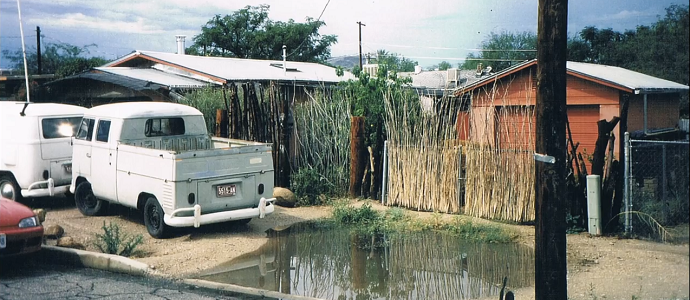When Brad Lancaster and his brother bought their home in downtown Tucson, the streetscape was a dusty place, devoid of trees or any vegetation. In 1996 Lancaster and his neighbors started an annual tree planting project, which up until now has resulted in over 1,400 native food-bearing trees being planted (usually with water-harvesting earthworks) in the neighborhood.
In 2004, Lancaster augmented the street tree planting by using a 14-inch, gas powered circular saw to cut away part of his curb to divert street runoff into his street-side tree basins. When the walkway in front of his home sprouted with life- like mesquite and palo verde trees- many of his neighbors wanted to cut their curbs as well. Lancaster approached the city to convince them to make his water-harvesting technique legal. It took three years for the city to change the rules. Today, three quarters of the neighbors on his block are harvesting rainwater.
Tucson receives just 11 inches of rainwater per year, but Brad argues this is enough. “Tucson has over a 4,000 year history of continuous farming despite this being a drylands desert community. People thrived creating crops, domesticating crops that are uniquely adapted to this climate, but in less than 100 years we almost wiped it out by becoming reliant on very extractive pumps, extracting the groundwater, diverting the river to the extent that we actually killed our river, we dropped our groundwater table over 300 feet so we didn’t want to plug into that paradigm.”
Today, Lancaster’s downtown Tucson neighborhood (Dunbar/Spring) is alive with drought-tolerant, food-bearing trees and residents harvest from the barrel cactus (chutneys, hair conditioner from fruit), the prickly pear cactus (juice, syrup & natural sweeteners from fruit), the ironwood tree (peanut-flavored nuts, processed like edamame), jojoba (oil, coffee substitute), mesquite (“native carob”, flour) and sweets from the “iconic saguaro cactus”.
Lancaster’s experimentation continues on his property: he calls the 1/8th of an acre site he shares with his brother’s family, his “living laboratory”. Here he plants around the greywater from his outdoor shower, bathtub and washing machine. He captures 100,000 gallons of rainwater per year on their property and surrounding public right-of-way. He cooks with a solar oven and heats his water using a 2 salvaged, conventional gas heaters stripped of insulation, painted black, and put in an insulated box with glass facing south to collect the sun’s rays.
Lancaster converted the old garage on the property into his 200-square-foot “garottage” (garage + cottage) or “shondo” (shed + condo). Nearly all the wood and materials are salvaged. The garage’s original cinder block walls weren’t insulated so he added 2 inches of foam insulation on the exterior to create “ex-sulation”. Lancaster relies mostly on passive solar to heat and cool his home, though he uses an evaporative cooler (swamp cooler) on hotter evenings. His kitchen is outside: a rainwater-plumbed sink, a hacked chest-freezer-turned-refrigerator and a propane camping stove.
His toilet is another experiment. “You can currently get a compost toilet that is manufactured and NSF-approved, but it costs $3000 or more. So we wanted to try making some site-built models that only cost $300 for which we got experimental permits.” His models include a urine-diverting barrel-style compost toilet (the urine is diluted to water plants and the fecal matter sits and composts for a year or more before being used as fertilizer) and a water-less standing urinal. Check it out below…
If you like this idea, be sure to share it with your friends and inspire someone you know. Anything becomes possible with just a little inspiration…

